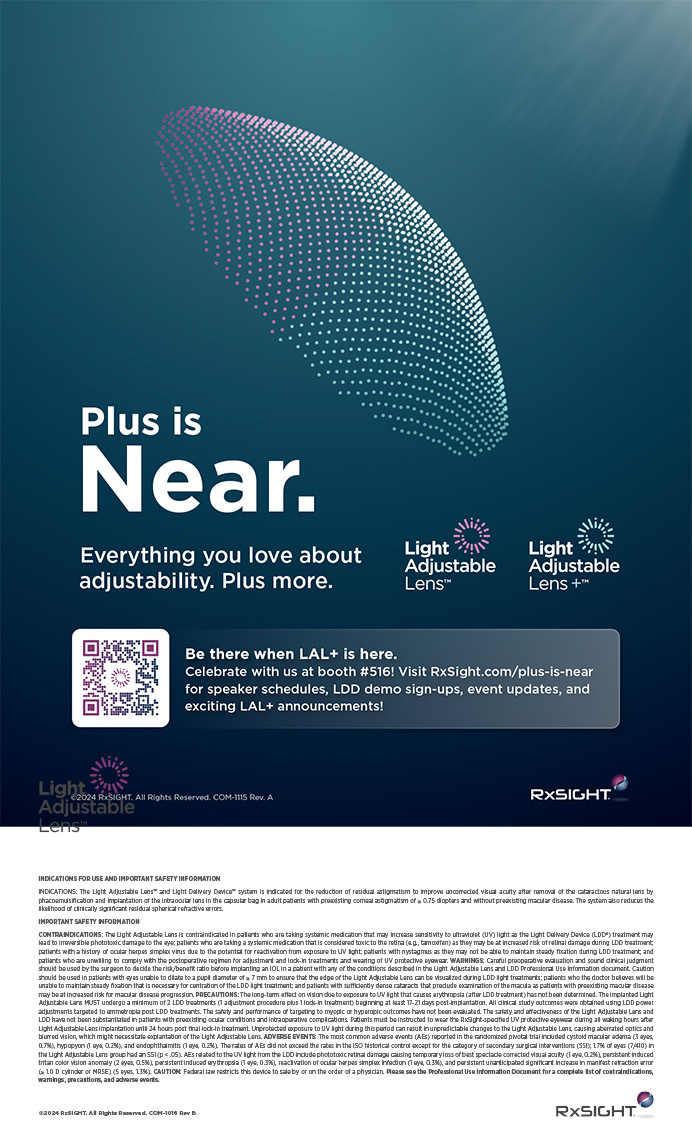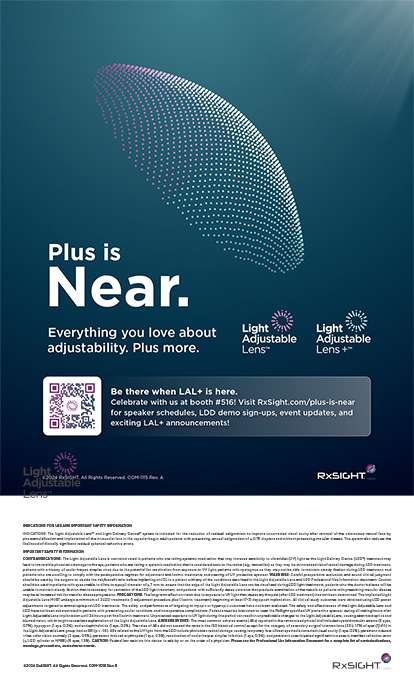
When you approach the treatment of a patient who has astigmatism as part of his or her refractive error, do you specifically look at both the corneal and refractive astigmatism measurements? Do you take into consideration how similar or different they are before setting the parameters for treatment? If you do, then you will have noticed that they are often quite different either in magnitude or axis or both.
The conundrum is even more compelling for those who perform both corneal and laser refractive surgery. It is hard to rationalize why, in the OR, one is mostly attempting to sphericize the cornea, but in the laser refractive suite the goal is to sphericize the refractive cylinder. This can be an issue when they differ, as they often do.
You might then ask yourself a question: Here you are, performing surgery for the same goal of correcting astigmatism to enhance vision; but why are you doing it under two different paradigms, chosen only based on which room you are operating in?
The differences between corneal and refractive values are easily quantifiable using the metric of ocular residual astigmatism (ORA). Since I first described this vector value in 1997,1 it has been shown in a number of studies2-5 that high preoperative ORA is associated with suboptimal visual outcomes. If high ORA is not identified ahead of time, these poor outcomes can be a surprise to both the surgeon and the patient expecting the perfect outcome.
But forewarned is forearmed, as the saying goes, when it comes to resolving a challenging astigmatic situation. At the very least, realistic expectations for a patient with high ORA can be identified ahead of time, even if no other treatment strategy such as vector planning is implemented. Alternatively, one might advise against surgery altogether, rather than risk patient dissatisfaction.
Corneas with irregular astigmatism, as in keratoconus, have larger amounts of ORA than healthy astigmatic eyes.6 The introduction of wavefront technology predictably did not address issues associated with this dichotomy, but a study that combined wavefront technology with vector planning showed an improvement over wavefront technology alone, despite these differences.7
Laser vision correction has exposed dilemmas not previously identified, and this has led to the creation of new parameters such as ORA to allow refractive surgeons to effectively treat astigmatism.
Questions for the panel:
No. 1: Do you consider the patient’s ORA when assessing refractive laser surgery candidates?
No. 2: If so, how do you modify your treatment plan to account for the ORA?

Considering the patient’s ORA. Dr. Alpins points out that today’s comprehensive refractive surgeon who performs both LASIK and IOL-based refractive procedures may be challenged by an apparent dichotomy of thought: “It is hard to rationalize why, in the OR, one is mostly attempting to sphericize the cornea, but in the laser refractive suite the goal is to sphericize the refractive cylinder.”
Dr. Alpins’ statement is timely, as improvements in diagnostic technology for LASIK and refractive lens exchange candidates have given us more simple and reliable means of describing these differences. Understanding the interplay between keratometric astigmatism and subjective refractive astigmatism, as quantified in the concept of ORA, has been tremendously useful for us, and we consider ORA in every refractive patient.
In our St. Louis center, LASIK (read: vision correction) patients go through an identical workup process whether they are 18 or 58 years old. The evaluation begins with Hartmann-Shack aberrometry, double-pass ocular scatter measurement, automated keratometry with an optical biometry device, tomography with a rotating Scheimpflug camera, and anterior segment OCT. Patients undergo three manifest refractions on two different days and a cycloplegic refraction. All seven of our cornea- and lens-based refractive procedures are performed in a single vision correction suite housing five lasers, one surgical microscope, and one ultrasound phaco system—a trend that has become more popular among US refractive surgeons in the past 2 years. Diagnostics, surgical planning, and surgical treatment are approached with a uniform refractive mindset that incorporates the concept of ORA across procedures.
Modifying the treatment plan. What do we do with ORA? I look for a consistent astigmatism story in terms of magnitude and direction. If ORA is significant, then one of these approaches may be warranted:
- Repeating testing that day or performing additional testing that might confirm congruence between refractive and keratometric astigmatism measurements;
- Giving the patient more time to be out of contacts and to optimize the tear film (in my experience, this will often minimize ORA);
- If the above measures don’t produce a consistent story, then this may favor taking an IOL-based approach (refractive lens exchange) rather than a phakic approach (LASIK, PRK, SMILE, phakic IOL) in patients who may otherwise do well with either route;
- If cornea or phakic IOL surgery is still indicated, then—depending on the amount of ORA—these data provide an impetus to set appropriate expectations and counsel the patient about the increased likelihood of requiring enhancement; and
- If an IOL is to be used in an eye with significant ORA, I often prefer a spherical IOL with an incisional keratotomy approach to a toric IOL. If a toric lens is placed and an overcorrection requiring enhancement occurs, then one is left having to use a laser or incisional approach to affect further flattening to the already relatively flat meridian. If keratoconic changes require topography-guided treatment down the road or if the patient desires to wear a rigid gas permeable lens due to corneal irregularity, then this is more straightforward in the setting in which a spherical IOL has been implanted.
Incorporating ORA helps take patients not just to 20/20 but to 20/happy or 20/ecstatic.

Considering the patient’s ORA. To understand the impact of ORA on refractive outcomes after LASIK, it is best to study eyes in which there was no refractive cylinder preoperatively. Obviously, in these eyes, there is no rationale for astigmatic treatment, and, therefore, any postoperative refractive cylinder has been induced either by the ablation or the flap preparation or by both.
But first, let us step back and recapitulate some basic thoughts. The contributors to refractive cylinder are the anterior cornea and the ORA. The ORA mainly results from contributions from the posterior corneal surface and the crystalline lens. ORA is defined as the vectorial difference between the corneal topographic astigmatism and the refractive cylinder. We know that treating astigmatism with LASIK based on manifest subjective refraction results in a more successful outcome if the preoperative refractive cylinder arises primarily from the anterior corneal surface.
In a study of 267 refractive plano eyes,8 we analyzed the amount of topographic astigmatism (ie, the amount of ORA) and tried to define a cutoff value beyond which treatment resulted in reduced treatment efficacy. To get a clear, intuitive picture of astigmatic changes, we applied the Alpins vector method. Moreover, we used receiver operating characteristic (ROC) analysis to find the cutoff value of preoperative ORA that could best discriminate between high and low treatment efficacy (efficacy index, or EI) and safety (safety index, or SI).
The ROC analysis showed that eyes with a preoperative ORA of 0.90 D or less reached an EI of at least 0.8 (the best sensitivity and highest specificity in the study) statistically significantly more frequently than eyes with a preoperative ORA of greater than 0.90 D. If the preoperative ORA or topographic astigmatism was maximally 0.80 D, then an EI of at least 0.9 (statistically significant) or greater than 0.9 (probable) was possible, although with a lower sensitivity and specificity. Therefore, an ORA cutoff of 0.90 D was chosen for the comparison of high and low preoperative ORA or topographic cylinder groups. For an SI of 0.9 or more, the preoperative ORA should be maximally 0.80 D.
Briefly, the study results showed that a low preoperative topographic astigmatism (ie, low ORA) was correlated with a low postoperative ORA and better refractive results (EI, SI, and distance BCVA). These differences were statistically significant.
Modifying the treatment plan. Our findings indicate that caution is recommended when a preoperative corneal astigmatism of 0.90 D or greater is present. We consider this result in determining our LASIK settings, even if the subjective refractive cylinder is neutral. In these cases, we correct 50% of the preoperative corneal topographic astigmatism following vector analysis according to Alpins.
PROFESSOR ALPINS REPLIES
Dr. Frings’ study8 is important for several reasons, two of which are worthy of comment here. First, this research has once again demonstrated that, in eyes with no refractive cylinder, an ocular residual astigmatism (ORA) equivalent to the corneal astigmatism will reduce the safety and efficiency of LASIK and produce poorer visual outcomes than in eyes with ORA below 0.90 D. This reinforces the need for ORA assessment prior to refractive surgery for all patients, as it can provide a source of prognostic advice for patients embarking on refractive surgery and can help them to avoid postoperative disappointment.
Dr. Frings has also extended the ORA red flag from an estimated 1.00 D to 0.90 D, demonstrating that this phenomenon exists in a significant proportion of eyes. The additional correction of 50% of what would have been astigmatism left on the cornea is one way of avoiding adverse outcomes.
It is not always easy to separate eyes that have no refractive cylinder, as ORA is prevalent in eyes that have both corneal and refractive cylinder. When the corneal astigmatism is greater than 0.90 D, the refractive cylinder may be well aligned, and the ORA may be relatively small. In this case, one needs to remember that high corneal astigmatism does not necessarily mean high ORA, demonstrating the need for its accurate calculation. This can be done on the free calculator application on www.assort.com.
Dr. Brinton has adopted the concepts of ORA into his practice very well. The simple calculation helps to verify the accuracy of the preoperative refractive and corneal measurements, which, if high, are acquired again to ensure they are accurate. As is often the case, the higher-than-average ORA may not change; if it doesn’t, the patient’s astigmatism is more challenging to correct. This fact is discussed with the patient during the consent process so that expectations can be kept at realistic levels. Like Dr. Frings, Dr. Brinton modifies his plan according to the confirmed parameters.
Lens-based surgery with a spherical IOL is certainly an option to remove any lenticular astigmatism component of ORA. The strategy of sphericizing the cornea with a spherical IOL has optical advantages to a toric IOL in a low astigmatic cornea. The other option (which will be discussed in a later installment of this column) is vector planning with refraction-driven treatments, so that less astigmatism remains on the cornea in healthy astigmatic eyes. This is particularly important in the presence of any corneal irregularity.
1. Alpins NA. New method of targeting vectors to treat astigmatism. J Cataract Refract Surg. 1997;23:65-75.
2. Kugler L, Cohen I, Haddad W, Wang MX. Efficacy of laser in situ keratomileusis in correcting anterior and non-anterior corneal astigmatism: comparative study. J Cataract Refract Surg. 2010;36(10):1745-1752.
3. Qian YS, Huang J, Liu R, et al. Influence of internal optical astigmatism on the correction of myopic astigmatism by LASIK. J Refract Surg. 2011;27(12):863-868.
4. Frings A, Katz T, Steinberg J, Druchkiv V, Richard G, Linke SJ. Ocular residual astigmatism: Effects of demographic and ocular parameters in myopic laser in situ keratomileusis. J Cataract Refract Surg. 2014;40:232-238.
5. Archer TJ, Reinstein DZ, Pinero DP, Gobbe M, Carp GI. Comparison of the predictability of refractive cylinder correction by laser in situ keratomileusis in eyes with low or high ocular residual astigmatism. J Cataract Refract Surg. 2015;41:1383-1392.
6. Alpins NA, Stamatelatos G. Customized photoastigmatic refractive keratectomy using combined topographic and refractive data for myopia and astigmatism in eyes with forme fruste and mild keratoconus. J Cataract Refract Surg. 2007;33:591-602.
7. Alpins NA, Stamatelatos G. Clinical outcomes for laser in situ keratomileusis using combined topography and refractive wavefront treatments for myopic astigmatism. J Cataract Refract Surg. 2008;34:1250-1259.
8. Frings A, Richard G, Steinberg J, Skevas C, Druchkiv V, Katz T, Linke SJ. LASIK for spherical refractive myopia: Effect of topographic astigmatism (ocular residual astigmatism, ORA) on refractive outcome. PLoS One. 2015;10(4):e0124313.




